Imagery Shows How a Cemetery for Russian Mercenaries Is Expanding

A cemetery used by the notorious Russian mercenary group Wagner has grown rapidly in size over the past several months, according to interviews and an analysis by The New York Times of satellite imagery and video footage. The expanded burial ground is rare visual evidence that shows the toll the invasion of Ukraine is taking on Wagner, especially its rank-and-file soldiers.
The expansion coincides with a bloody offensive by Russian soldiers and mercenaries to gain ground in eastern Ukraine. The U.S. government says that Wagner’s battlefield casualties are in the thousands and that 90 percent of them are inmates who were recruited to fight in exchange for being released from prison, assuming they survived.
A satellite image captured on Jan. 24 shows about 170 burial plots in an area of the cemetery known to hold Wagner fighters, a number that has increased to nearly seven times that seen on satellite imagery just two months ago.

A dramatic expansion of Wagner burial plots in the village of Bakinskaya occurred over the past two months.Credit…Maxar Technologies
Wagner’s cemetery is a recent addition to its growing infrastructure inside Russia, where it seeks to position itself as a superior fighting force over the Russian military. The graves’ existence, near the group’s primary training facility in the southeastern village of Molkin, was first made public in December by Vitaly Wotanovsky, an activist and a former Russian Air Force officer.
Mr. Wotanovsky, 51, told The Times that he visits graveyards to document cases of Russians who have been killed while fighting in Ukraine. The cemetery’s location might have remained unknown had local residents not tipped him off that the area was being used to bury the unclaimed bodies of Wagner fighters. Over the course of several visits, he photographed a growing number of grave markers and uploaded them to his Telegram channel, Titushki in Krasnodar.
“Our goal is to show people that war results in deaths, and it’s not somewhere far away or on TV, but it’s here next to us,” Mr. Wotanovsky said.
There may be even more dead than what is easily visible. He noted that locals had told him many fighters had most likely been cremated.
For years, Wagner’s mercenaries have kept a low profile while operating abroad in countries like Syria, Libya and the Central African Republic. The United Nations and human rights groups accuse the group of targeting civilians and conducting mass executions.
But since the start of the war in Ukraine, the group has expanded its public presence with promotional videos and claims of its own fighting prowess — much of this led by the group’s public face, Yevgeny Prigozhin.
In a video that emerged last September, Mr. Prigozhin hinted at the cemetery’s existence while recruiting inmates from Russia’s penitentiary system, promising to take care of their remains if they died in combat.
“For those who do not know where they want to be buried, we bury them near the chapel of PMC Wagner,” he said.

A video that emerged last September gave a rare glimpse into how Wagner attempts to recruit prison inmates to fight in Ukraine.
Ten days after Mr. Wotanovsky revealed the cemetery’s location, several videos were published by pro-Kremlin media outlets showing Mr. Prigozhin laying flowers at a grave in the cemetery. Also visible are rows of freshly dug graves, each adorned with wreaths in the shape and colors of Wagner’s logo.
“He works a lot on heroifying — it’s now a sort of Russian policy: why hold onto this life, when you can die so heroically,” said Olga Romanova, the founder of Russia Behind Bars, a charity organization that assists convicts and their families. “Death is not horrific. What’s horrific is the opposite: not to die for the Motherland.”
That footage, and Mr. Wotanovsky’s photos, also offers clues about who has been fighting, and dying, for Wagner in recent months. At least 16 of the names and birth dates seen on grave markers appeared in online databases of people convicted of crimes in Russia. Many probably died in fighting around the Ukrainian towns of Bakhmut and Soledar, where the mercenaries and the Russian military have sustained heavy losses over the past four months.

Mr. Prigozhin visited the Wagner cemetery 10 days after its location was made public by a local activist.
In another video, Mr. Prigozhin visited Wagner’s chapel, about eight miles from the cemetery. The footage showed the mercenary company emulating the ways in which a country’s official military might memorialize its own war dead, with grand monuments and murals on well-manicured grounds.
Also present are rows of black walls containing compartments typical of how cremated remains are interred. Each compartment has an identification number and a display of the deceased’s combat awards.
The Times identified 21 walls in total at the chapel, each containing 42 compartments, suggesting that hundreds of deceased Wagner fighters are either interred or, at the very least, memorialized at the chapel. It is unclear if all of these fighters were killed in Ukraine, or elsewhere, but the footage still offers a rare look at the scale of Wagner’s losses.

Footage of Mr. Prigozhin’s visit to Wagner’s chapel showed the group seeks to emulate the ways in which a country’s official military might memorialize its own war dead.CreditCredit…RIA Novosti
On Friday, the White House said it would designate Wagner a transnational criminal organization. Wagner is already under U.S. sanctions, but this new measure would, in part, bar Americans from providing money, goods or services to the company.
Aaron Byrd and Alexander Cardia contributed production.
